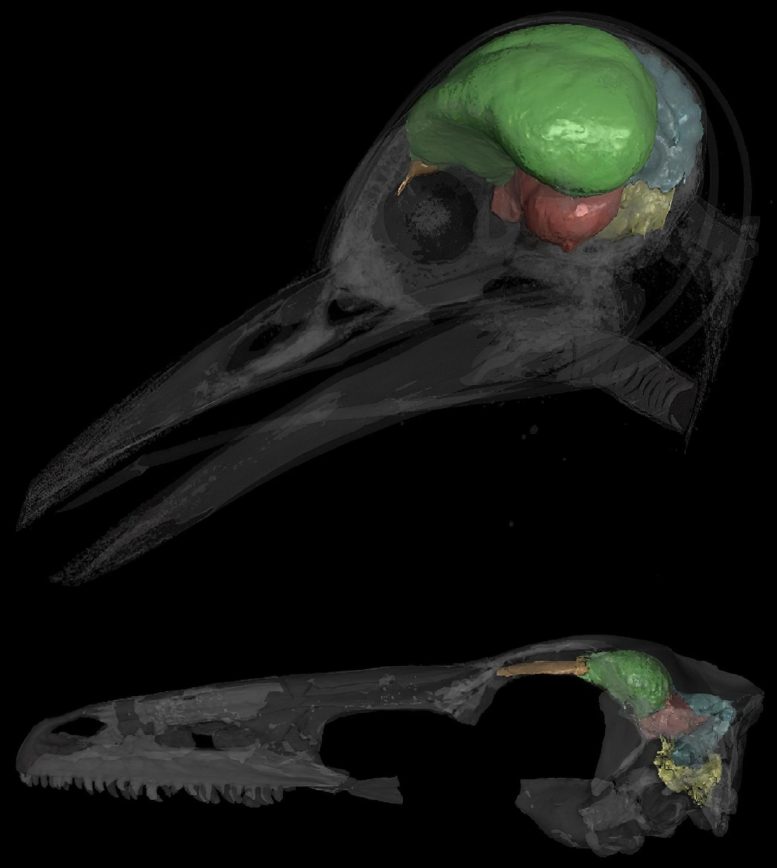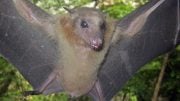
Digital reconstructions of endocasts of a woodpecker, Melanerpes aurifrons (top), and a troodontid dinosaur, Zanabazar junior (bottom). The blue area is the cerebellum. Credit: Amy Balanoff
Evolutionary biologists at Johns Hopkins Medicine report they have combined PET scans of modern pigeons along with studies of dinosaur fossils to help answer an enduring question in biology: How did the brains of birds evolve to enable them to fly?
The answer, they say, appears to be an adaptive increase in the size of the cerebellum in some fossil vertebrates. The cerebellum is a brain region responsible for movement and motor control.
The research findings were recently published in the journal Proceedings of the Royal Society B.
The Importance of the Cerebellum in Flight
Scientists have long thought that the cerebellum should be important in bird flight, but they lacked direct evidence. To pinpoint its value, the new research combined modern PET scan imaging data of ordinary pigeons with the fossil record, examining brain regions of birds during flight and braincases of ancient dinosaurs.
“Powered flight among vertebrates is a rare event in evolutionary history,” says Amy Balanoff, Ph.D., assistant professor of functional anatomy and evolution at the Johns Hopkins University School of Medicine and first author of the published research.
In fact, Balanoff says, just three groups of vertebrates, or animals with a backbone, evolved to fly: extinct pterosaurs, the terrors of the sky during the Mesozoic period, which ended over 65 million years ago, bats, and birds.
The three species are not closely related to the evolutionary tree, and the key factors or factors that enabled flight in all three have remained unclear.
Besides the outward physical adaptations for flight, such as long upper limbs, certain kinds of feathers, a streamlined body, and other features, Balanoff and her colleagues designed research to find features that created a flight-ready brain.
To do so, she worked with biomedical engineers at Stony Brook University in New York to compare the brain activity of modern pigeons before and after flight.
Methodology and Findings
The researchers performed positron emission tomography, or PET, imaging scans, the same technology commonly used on humans, to compare activity in 26 regions of the brain when the bird was at rest and immediately after it flew for 10 minutes from one perch to another. They scanned eight birds on different days.
PET scans use a compound similar to glucose that can be tracked to where it’s most absorbed by brain cells, indicating increased use of energy and thus activity. The tracker degrades and gets excreted from the body within a day or two.
Of the 26 regions, one area — the cerebellum — had statistically significant increases in activity levels between resting and flying in all eight birds. Overall, the level of activity increase in the cerebellum differed by more than two standard statistical deviations, compared with other areas of the brain.
The researchers also detected increased brain activity in the so-called optic flow pathways, a network of brain cells that connect the retina in the eye to the cerebellum. These pathways process movement across the visual field.
Balanoff says their findings of activity increase in the cerebellum and optic flow pathways weren’t necessarily surprising, since the areas have been hypothesized to play a role in flight.
What was new in their research was linking the cerebellum findings of flight-enabled brains in modern birds to the fossil record that showed how the brains of birdlike dinosaurs began to develop brain conditions for powered flight.
To do so, Balanoff used a digitized database of endocasts, or molds of the internal space of dinosaur skulls, which when filled, resemble the brain.
Balanoff identified and traced a sizable increase in cerebellum volume to some of the earliest species of maniraptoran dinosaurs, which preceded the first appearances of powered flight among ancient bird relatives, including Archaeopteryx, a winged dinosaur.
Linking Modern Birds to Dinosaur Ancestors
Balanoff and her team also found evidence in the endocasts of an increase in tissue folding in the cerebellum of early maniraptorans, an indication of increasing brain complexity.
The researchers cautioned that these are early findings, and brain activity changes during powered flight could also occur during other behaviors, such as gliding. They also note that their tests involved straightforward flying, without obstacles and with an easy flight path, and other brain regions may be more active during complex flight maneuvers.
The research team plans next to pinpoint precise areas in the cerebellum that enable a flight-ready brain and the neural connections between these structures.
Scientific theories for why the brain gets bigger throughout evolutionary history include the need to traverse new and different landscapes, setting the stage for flight and other locomotive styles, says Gabriel Bever, Ph.D., associate professor of functional anatomy and evolution at the Johns Hopkins University School of Medicine.
“At Johns Hopkins, the biomedical community has a wide-ranging set of tools and technology to help us understand evolutionary history and link our findings to fundamental research on how the brain works,” he adds.
Reference: “Quantitative functional imaging of the pigeon brain: implications for the evolution of avian powered flight” by Amy Balanoff, Elizabeth Ferrer, Lemise Saleh, Paul M. Gignac, M. Eugenia L. Gold, Jesús Marugán-Lobón, Mark Norell, David Ouellette, Michael Salerno, Akinobu Watanabe, Shouyi Wei, Gabriel Bever and Paul Vaska, 31 January 2024, Proceedings of the Royal Society B.
DOI: 10.1098/rspb.2023.2172
In addition to Balanoff and Bever, other authors of the study are Elizabeth Ferrer of the American Museum of Natural History and Samuel Merritt University; Lemise Saleh and Paul Vaska of Stony Brook University; Paul Gignac of the American Museum of Natural History and University of Arizona, M. Eugenia Gold of the American Museum of Natural History and Suffolk University; Jesús Marugán-Lobón of the Autonomous University of Madrid; Mark Norell of the American Museum of Natural History; David Ouellette of Weill Cornell Medical College; Michael Salerno of the University of Pennsylvania; Akinobu Watanabe of the American Museum of Natural History, New York Institute of Technology College of Osteopathic Medicine, and Natural History Museum of London; and Shouyi Wei of the New York Proton Center.
Funding for the research was provided by the National Science Foundation.









Why is Jurassic park science so popular it has no science it can not be debate because it’s not science .flying pterosaur first it was aquatic but was not marketable now a flying animal sound like rest of dinosaur it was a crocodilian because of teeth but it is common animal today so it is not marketable.clearly pterosaur could not fly giant horned and giant skull larrry Martin team see it as joke like me .archaeopteryx and troodon are birds they are not dinosaur won is flying bird the other is flightless bird
The dinosaur the spinosauridae dinosaur the gator the vertebrae has feature found in fish dinosaur lizard mammal .the first mesoeucrocodylia the gator type mesoeucrocodylia the vertebrae is very different from eusuchian the modern crocodilian type it’s fish like amphicoelous some has eusuchian type vertebra but it’s very rare a lizard tuatara type vertebra some has dinosaur type vertebrae opisthocoelous the eusuchian has procoelous vertebra like like lizard .the neck of gator are like mammal because of death roll the atlas and axis they are fuse for better head movement a new technology in vertebrae it’s very rare in reptiles only in sauropod and mesoeucrocodylia it rare sauropod
Rare in sauropod .gator tail is not very flexible it is not like none tetanuran dinosaur tail that came from aquatic animal like all thecodont the gator has pygostyle tail like all tetanuran dinosaur and birds it’s upgrade tetanuran design tail with aquatic feature .so spinosaurus tail did not turn into none tetanuran dinosaur tail like the gator .the gator has 7 vertebrae fuse the tail that is a pygostyle tail
Gator first vertebrae tail bone is biconvex a new technology without a scientific name .biconvex means bone end are the same two ball joint centra now the tall is very flexible .sauropod and gator spinosauridae cervicalneck are very simular the cervical ribs it is not like heterocoelous bird that have nothing to do with dinosaur .there neck ribs are small in sauropod and gator for good neck movement the best in dinosaur most dinosaur have primitive neck ribs like tuatara the big ribs but not all ribs are small in sauropod and gator the neck is fix poor movement in mammal bird and fossil bird troodonvelciraptorarchaeopteryx it is small and it is fuse to vertebrae in reptiles it is not only when disease
Tall =tail flexible.sauropod and gator has torsion problem so they have occified tendon in the neck the torsion problem affect the neck the most the atlas axis death roll system in gator.sauropod and gator spinosauridae the atlas and axis are small compare to other dinosaur these neck are complete different the gator neck attach to skull differently like duckbill dinosaur likely a quadrupedal feature not a aquatic feature because they say crocodilian ancestor is pseudosuchian I did not check fake crocodilian ancestor neck .duckbill dinosaur shows how it is done because they only one dinosaur group .one of spinosauridae dorsal vertebrae is very simular to early mesoeucrocodylia it is amphicoelous this is very rare in dinosaur they have opisthocoelous vertebrae the ball joint is in the front lizard eusuchian is in the back in carnotaurus maiakasaurus the early dinosaur it is found on the tail they talk about how rare it is on tail
In birds atlas axis are not fuse like most dinosaur this is strange bird is known for great neck movement and head movement because of flight because of feather they can touch there back I guest it’s heterocoelous .i herd fossil bird vertebrae is diffferent but They still has short neck ribs .the famous flightless bird deinychus the axis is different from carnotaurus allosaurus
They were running and gliding first…the mechanics of flapping and control followed..
If you believe birds are dinosaurs, or evolved from dinosaurs, then you have officially drank the koolaid.
Just because 2 kinds lived at the same time does not mean they are the same.
Go research the evidence yourself and you will see many examples of redefining words, assumptions, and outright lies to make this false narrative.
“…Balanoff says, just three groups of vertebrates…evolved to fly: extinct pterosaurs,…bats, and birds. The three species are not closely related to the evolutionary tree…”
I stopped reading at this sentence, as the writer clearly doesn’t know the definition of a species.
Deinychus deinonychus.spinosauridae show how it turn into the gator .the link was not as detail what I want they did not say if the atlas axis are fuse and if it has a mammal odontoid only say they different from other vertebrae which is good sign thou .the link a fish eating dinosaur from the wealdon of surrey .this same link with turbinate allso bad they say nasal fenestra like the gator no turbinate I use ankylosaurus link for that they said turbinates
Dinosaur could not climb trees flight came from the tree .the dinosaur ankle are fuse and to tibia the last surviving dinosaur the gator ankle are not fuse and tibia are not fuse to ankle the dinosaur arm have bad movement the best is allosaurus the arm are design for grasping and impale the arm could not put food in the mouth it bite first.gator are good tree climber .pterosaur dinosaur is a dinosaur it’s digetgrade a feature of thecodont dinosaur a fact it’s a very aquatic dinosaur because it has whale nose the dinosaur are design for land not fight or water that why lost of kink snout a fish eating feature very rare in tetanuran dinosaur it found in gator spinosaurus
Clearly dinosaur are very primitive the first dinosaur has palate teeth a tuatara feature that is not a feature of pseudosuchian dinosaur that fish feature some early thecodont has palate teeth as badit scientist call it archosaurifornies teeth no gum teeth the teeth fuse to skull.early bird hip dinosaur scapulocoracoid are not fuse the basisphenoid are not fuse allso in one tetanuran .dinosaur clearly show how it turn into greatest dinosaur ever the modern crocodilian if you say dinosaur is more advance than the gator it’s like saying insect is more advance than mammal they are rewritering science fact
Advance pterosaur has kink snout they have palate teeth early pterosaur did not have kink they did not find won yet this is rather strange pterosaur have all these advance dinosaur feature it allso has pygostyle tail this show how flight aquatic can convergent evolution i do not know how many bones are fuse i know bird has 7 fuse like the gator sometime only 5 vertebrae in the tail
I thought I understand atlas axis complex I guest no I here they said the neck lack neural arch in the gator because they know atlas and axis are special vertebra and it’s a death roll feature I did not here about this special important feature in early mesoeucrocodylia the said all neck has neural arch I would have investigate it more .the link.vertebra picture of the week sv pow atlas axis complex sauropod.torsion and bending in the neck and tail of sauropod plos org plos one.torsion and bending in the neck and tail of researchgate .zoonerdy.6vertebra column of the turtle shell UC Berkeley.carnotaurus Bonaparte horned researchgate.